Pregnancy: Fetal Development slideshow:
Fetal development is a fascinating journey that unfolds over the course of nine months, as a tiny embryo transforms into a fully formed baby. Understanding the intricate changes that occur each month can provide expectant parents with valuable insights into the growth and development of their unborn child.
First Trimester: The Foundation of Fetal Growth (1-3 months)
Month 1 (Pregnancy: Fetal Development slideshow)
During the first month of pregnancy, significant developments occur in the embryo. The amniotic sac, a protective water-tight membrane, forms around the fertilized egg, providing cushioning throughout pregnancy. Additionally, the placenta, a vital organ responsible for transferring nutrients and waste between mother and baby, begins to develop.
At this early stage, the embryo starts taking shape, with a primitive face featuring large dark circles for eyes, developing mouth, lower jaw, and throat. Blood cells start forming, initiating circulation in the tiny body. By the end of the first month, the embryo measures around 6-7mm (1/4 inch) in length, approximately the size of a grain of rice.
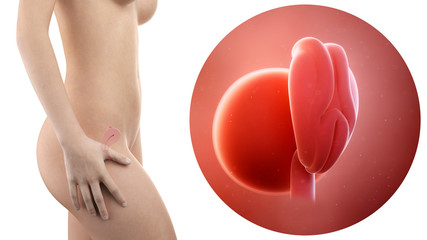
Month 2
In the second month, the embryo continues its transformation into a fetus. Facial features further develop, with ears beginning as small folds of skin and buds forming for arms, legs, fingers, toes, and eyes. The neural tube, precursor to the brain and spinal cord, is well formed, and organ development progresses, including the digestive tract and sensory organs. Bone starts replacing cartilage, and although movement begins, it’s not yet perceptible to the mother.
By the end of the second month, the fetus measures approximately 2.54cm (1 inch) in length, weighing around 9.45g (1/3 ounce), with a significant portion comprising the head.
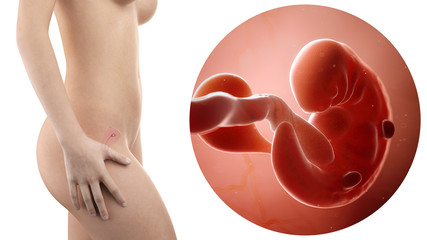
Month 3
In the third month, the fetus becomes fully formed, with developed arms, hands, fingers, feet, toes, and the ability to open and close fists and mouth. Nails start to form, and internal organs like the liver, circulatory system, and urinary system become functional. Reproductive organs develop, although gender determination via ultrasound remains challenging. By the end of the third month, the fetus measures about 7.6 -10 cm (3-4 inches) in length and weighs around 28g (1 ounce).
At this stage, the risk of miscarriage significantly decreases, as the most critical stages of development have passed.
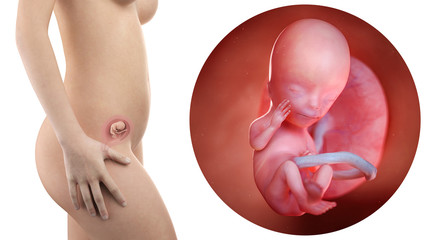
Second Trimester: Rapid Growth and Maturation (4-6 months)
Month 4: Growth Spurt and Movement
During the fourth month, the fetus experiences a significant growth spurt, doubling in size from the previous month. Limbs elongate, and joints form, allowing for increased movement. By the end of the fourth month, the fetus can make spontaneous movements, although these may not be felt by the mother yet.

Month 5: Senses and Reflexes
In the fifth month, the fetus’s sensory organs continue to develop, and it becomes more responsive to external stimuli. Taste buds form on the tongue, and the fetus can swallow amniotic fluid. Reflexes, such as sucking and swallowing, are also present. By this stage, expectant mothers may start to feel the first fluttering movements of their baby, known as quickening.
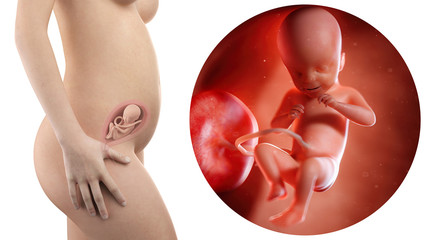
Month 6: Lung Development and Viability
During the sixth month, the fetus’s lungs undergo rapid development in preparation for breathing air at birth. Alveoli, the tiny air sacs where gas exchange occurs, begin to form. While the fetus is still considered premature and would require medical intervention to survive if born at this stage, its chances of survival outside the womb gradually increase.
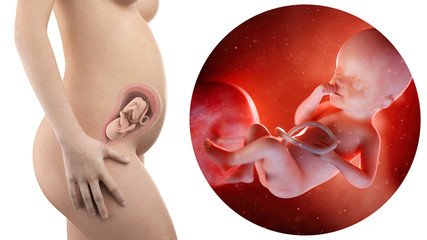
Third Trimester: Final Preparations for Birth (7-9 months)
Month 7: Brain Growth and Maturation
In the seventh month, the fetus’s brain continues to grow and mature at a rapid pace. Neuronal connections multiply, laying the foundation for cognitive abilities such as learning and memory. The fetus also begins to exhibit more organized patterns of sleep and wakefulness.
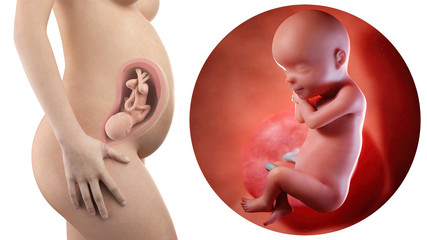
Month 8: Weight Gain and Final Preparations
During the eighth month, the fetus undergoes significant weight gain as it accumulates adipose tissue for insulation and energy reserves. Vernix, a protective coating, covers the skin to prevent it from wrinkling due to prolonged exposure to amniotic fluid. The fetus assumes a head-down position in preparation for birth.

Month 9: Ready for Birth
In the final month of pregnancy, the fetus is fully developed and ready for birth. It continues to gain weight and mature, with its organs and systems functioning optimally. The mother may experience Braxton Hicks contractions as the uterus prepares for labor. At the end of the ninth month, the baby is typically born, marking the end of pregnancy and the beginning of parenthood.
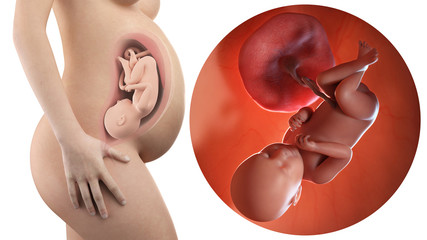
Sources
- American College of Obstetricians and Gynecologists (ACOG)
- Mayo Clinic
- The American Pregnancy Association
- National Institutes of Health (NIH)
- Centers for Disease Control and Prevention (CDC)